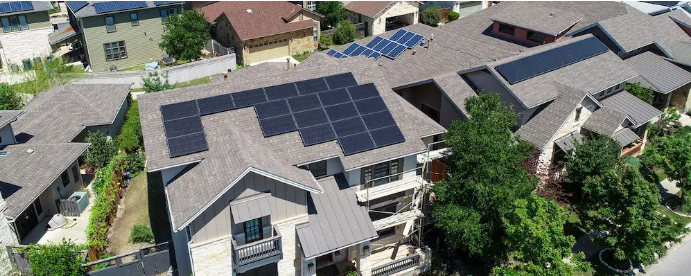FranklinWH is a newer company in the U.S. home energy storage market, but it could soon be a household name. The company currently offers a single energy storage system model it calls Franklin Home Power system, or FHP for short, and it’s been turning heads in the industry and the marketplace.
FranklinWH says the FHP can do whole-home backup (the WH in the company’s name stands for “Whole Home”). They claim it will connect to any existing solar inverter, start air conditioners up to 4 tons in size, and charge from solar, the grid, or a backup generator.
If you’ve been looking for a home battery storage system, you might be very impressed with the abilities described above. Not many batteries on the market can match what FranklinWH claims its FHP system can do.
Does the FHP live up to these claims? Read on to find out!
The components of the FranklinWH Power System

The FHP consists of three components:
- A 13.6-kilowatt-hour (kWh) lithium iron phosphate battery unit called the aPower
- A smart energy management unit called the aGate
- The FranklinWH smartphone app, which controls the smart circuits and allows users to customize their FHP system to their needs.
aPower batteries
The aPower battery comes with its own inverter in a very nice-looking box, with a sleek design and a grouping of LEDs on the front that indicate the state of charge. Having the inverter included means the aGate is an AC coupled battery, which connects to your home’s wiring only after the stored DC energy has been converted for use in your home.
One aPower battery unit weighs in at 408 lbs and measures 45.3” x 29.5” x 11.4”. It can be mounted on the wall or on the ground. The battery unit holds 13.6 kWh of lithium iron phosphate (LFP) battery cells. The unit can output 5,000 watts of continuous power and surge to 10,000 watts for 10 seconds. This is enough to start a 4-ton air conditioner.
Each additional aPower unit adds battery capacity and power output. For example, two units can output 10,000 watts continuously and surge to 20,000 watts, and three units can output 15,000 continuous watts and surge up to 30,000 watts. As many as 15 aPower battery units can be wired in parallel to a single aGate.
aGate smart energy management system
The aGate unit is where the battery meets the rest of the home. It has connections for the grid, the aPower battery, solar input, backup and non-backup loads panels, smart circuits, and a generator. The aGate can control all of your home’s appliances up to 160A, and can additionally manage the smart circuits to shut down certain loads when necessary.
There are two smart circuits inside the aGate, one 50A and one 80A. These can be connected to power-intensive appliances, EV chargers, or noncritical loads sub-panels and be set to automatically shut down if battery power is low in a grid outage situation through the app. You can also set schedules or manually control these smart circuits with the app.
The aGate controls battery charging and power flow in the home. It can be set to charge the batteries from solar, the grid, and even an AC backup generator. FranklinWH says the FHP can work with any existing solar inverter and accepts up to 80A of 240V output, which works out to about 19.2 kW. The wall-mounted aGate unit weighs 50 lbs and measures 31.5” x 21.7” x 6.3”.

One final selling point for the aGate is the ability to do “solar black start.” That means the FHP can operate completely independent of the grid using solar energy.
Essentially, the system will shut down if the battery gets too low during a power outage and there isn’t a backup generator available. The next morning as the sun comes up, the aGate will send a pulse signal to your solar inverter to check if it can produce enough power to start charging the battery. The aGate sends this pulse signal once per hour from 10 a.m. to 2 p.m. When it receives a positive response, the inverter will start up, the battery will start charging, and your home will be powered by your solar system.
The FranklinWH app
Using the FranklinWH app, owners can control how the battery charges and discharges. The battery can be set for self-consumption, backup standby, or load shifting, which means using backup power during peak usage times to save money under a Time of Use rate plan.
As mentioned above, the app also allows automatic scheduling of smart loads like EV chargers and other power-hungry appliances, along with manual control of these circuits during a power outage. During a grid outage, the aGate acts as its own wireless hotspot so you can still connect to the app and control the battery.
Finally, the app provides a real-time and historical display of energy generation, consumption, and battery use based on data from the aGate.
Cost and warranty
As of late 2022, the average wholesale price of the Franklin Home Power system is $15,000. Add about $2,500 to that number for installation costs, and you’re at $17,500 all in. For that price, you get one aPower and one aGate. Additional aPower units can be purchased for $11,500 wholesale, with probably $1,000 for installation, depending on your location and installer.
That said, FranklinWH is offering its installer partners different pricing and bonuses for selling a certain number of units, so you may find a better deal than the prices listed above. Also, your final cost is likely to be lower, considering the FranklinkWH battery qualifies for the federal clean energy tax credit.
For your money, you get all the functionality described above with a 12-year warranty, which covers defects in materials and workmanship as well as energy throughput. Specifically, FranklinWH says the aPower will retain at least 70% of its initial 13.6-kWh capacity by the end of the 12-year warranty or a minimum of 43 megawatt-hours (MWh) of throughput.
To put that into perspective, that means the aPower could be fully discharged and recharged 3,160 times before hitting its minimum throughput warranty. In order to get the full 12 years of coverage (4,383 days), you could discharge the battery an average of 9.8 kWh per day for the entire warranty period.
If the system suffers a defect within the warranty period, FranklinWH will repair the defective equipment or replace it with a new or refurbished battery.
How the FranklinWH energy storage solution matches up
Compared to other lithium-ion home batteries on the market, the FHP system offers more features and is more expensive from a dollars-per-kWh perspective. In general, true whole-home backup is very expensive, and only the FranklinWH FHP is designed to do it out of the box.
The Generac PWRcell system can also do whole-home backup as long as its modular battery cabinet is full with 18 kWh of batteries and paired with Generac’s PWRmanager load control system. And if you want true whole-home backup with the Tesla Powerwall, you’ll likely need at least two or three batteries, potentially each tied to their own sub-panel or connected to something like the SPAN smart electrical panel to ensure they can deliver enough power to the loads in your home.
Despite all this talk of whole-home backup, it’s important to note that none of the batteries described above are being marketed by their manufacturers for off-grid use, nor are they designed to provide backup to life-supporting systems or other medical equipment.



